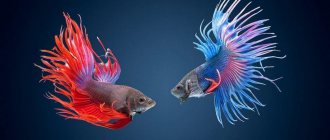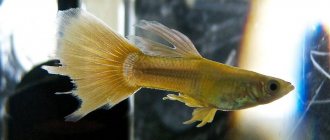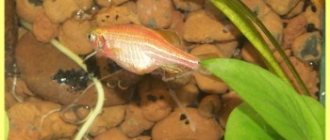Share this article:
Those who have owned an aquarium for a long time or recently are probably familiar with the feeling of concern for health and even life at the sight of a “ward” whose usual behavior or appearance has changed. One of the common causes of such experiences is bloating in the fish. In this article we will try to figure out what its causes may be and how to correct the situation.
Reason 1. Appearance of caviar
This is perhaps the most pleasant and harmless reason for a fish to bloat its abdomen. Caviar forms and develops in the female's abdomen, due to which the abdomen can become quite impressive.
What to do: be patient and wait for spawning, properly caring for the expectant mother.
Viviparous fish are capable of producing fairly large and fully viable fry. The process of bearing eggs is called pregnancy.
Prevention of dropsy
The best prevention of the disease is maintaining the necessary living conditions and minimizing stress. Find out at what temperature and pH of water the fish feel most comfortable in your aquarium. As a rule, these are the conditions of the natural habitat of this breed. A sharp change in temperature and water-salt conditions or their prolonged disturbance significantly increases the likelihood of disease in principle.
In addition, the quality of nutrition is of fundamental importance: the use of expired, dirty food, underfeeding or, most often, overfeeding is unacceptable. Water pollution also causes a decrease in immunity, so the incidence of dropsy is higher in places where the water in the aquarium is changed less frequently, that is, the excrement of the inhabitants accumulates in the soil.
Most non-aggressive fish require hiding places in the aquarium landscape, especially in the presence of more aggressive neighbors. The inability to hide is a big stress for a calm fish.
The principle of prevention is simple - the less stress a fish has to endure, the more successfully its body will cope with the threat of disease.
Reason 2. Overfeeding
Some fish swallow large pieces of food, which can then remain in their body for up to several days, bloating their bellies and causing indigestion. To prevent this from happening, break up your food into smaller pieces.
Intemperance in nutrition leads to obesity in fish, as a result of which their bellies also become swollen.
What to do: unfortunately, in advanced stages nothing can be done; in almost all cases the disease ends in death.
During life, such fish often additionally suffer from abdominal dropsy and cannot reproduce due to obesity in the ovaries and testes. To avoid this misfortune, you need not to overfeed the fish, give them fasting days, and feed adult fish much less than young ones.
Reason 3. Inflammation of the gastrointestinal tract
This problem often befalls fish from aquarists who do not attach importance to the quality and variety of food. The stomach and intestines can become inflamed. The fish become lethargic, weakened, their body color and fins darken, their excrement changes, their sense of balance is lost, and their abdomen swells. At the same time, the appetite is preserved.
What to do: do not get carried away with dry food; rinse, soak, and, if necessary, disinfect food (bloodworms and tubifex); diversify your diet.
Video
How to re-seal jars of pickles when the lids swell
The battery is swollen! How to solve the problem... Reanimating a swollen battery
IDEAL WAY TO SOAK SALTED FISH, Dried fish, How to salt correctly, how much to soak fish
The jar of cucumbers has become cloudy and swollen! What to do?
Poisonous Puffer Fish Caught, Tricked and Released
ZOO-portal EXOTICS
Add a comment
Reason 4. Disease “abdominal dropsy” or aeromonosis
They bring it into the aquarium along with soil, driftwood, plants, snails, food, fish from a natural reservoir or another contaminated aquarium.
The disease can be identified by ruffled scales that make the fish look like a pine cone, rapid breathing, weakness, dull color, inflammation and swelling of the abdomen and sides.
Infections caused by the bacterium Aeromonas punctata lead to illness. Pathology also occurs against the background of hexamitosis. Fish of all species and ages can catch it, but those at risk include those who are old, weak, obese, under constant stress, and living in poor conditions. The disease is contagious and enters the body through small wounds on the body.
What to do:
- For prevention: create normal living conditions, feed them properly and variedly, keep new fish in quarantine before placing them in a community aquarium.
- For healing: place in a separate vessel and take medicinal baths with special preparations. You can buy them at pet stores. The proportions and treatment regimen are written in the instructions.
Diseases of aquarium fish
An aquarium can decorate any interior and the leisurely life in it is very interesting to watch. To keep the aquarium clean and the inhabitants healthy, you need to make a lot of effort. However, sometimes fish can get sick. What is the cause of fish diseases?
There are many factors influencing the health of fish:
- Poor water quality. Tap water must be settled and, if necessary, special preparations must be added to bring the water to a state suitable for life for fish and other aquarium pets.
- Disturbance of the balance when changing the water or improperly starting the aquarium, or populating it with fish too early.
- Overfeeding The water becomes polluted, its quality decreases, and the fish don’t feel too good from overeating; many of them lack a sense of proportion.
- Overpopulation, incompatibility of inhabitants. Before you buy the fish you like, you need to find out the conditions under which it is kept and whether it gets along with the other inhabitants of your aquarium. Also consider population density. There shouldn't be too many fish.
- Failure to maintain quarantine for new fish and the introduction of sick animals. After purchasing, the new fish must be placed in a separate aquarium for quarantine. This is done to make sure that the fish is healthy and will not infect other inhabitants of your aquarium. The quarantine period is from 3 to 8 weeks, because it is during this period that the disease, if it exists, should already appear.
Main diseases and their manifestations
Pseudomonosis (fin rot)
The causative agent is the bacterium Pseudomonas. One of the most common diseases. It develops most often in heavily polluted water, as well as when kept in too cold water. A bacterial infection is manifested by erosions of the fins, the appearance of a cloudy bluish coating on them, and red dots are also often visible. At first, the erosion is located at the edge of the fin, later the fin breaks up into rays, the rays disappear at the ends, the erosion line is usually clearly visible due to its white-bluish color. In young fish, the fins often disintegrate to the base, where a white ulcer forms, bones may even be exposed, and the fish dies. Salt baths, bicillin-5, chloramphenicol, and streptocide are used for treatment.
Saprolegniosis
A fungal disease, the causative agent is Saprolegnia molds. More often it develops as a secondary infection in heavily polluted water or in fish weakened by another disease. It is manifested by the appearance of a cotton-like white or light yellow coating and thin white threads on the affected area. It can affect any part of the body, most often the gills, fins, eyes, and eggs. The rays of the fins stick together and are destroyed; if the fungus is on the gills, the gill filaments become gray and die; if in front of the eyes, the fish loses its vision and the eye turns white. A sick individual loses its appetite, becomes inactive, and lies more on the bottom. Without treatment and improvement of conditions in the aquarium, the fish most often die. Treatment - streptocide, bicillin-5 is used in a general aquarium, salt, copper sulfate are used in a separate container (be careful, if the dosage is incorrect, it will harm the fish). Easily preventable if you keep your aquarium clean.
Ascites (dropsy)
It often appears as a symptom of many diseases, parasitic and bacterial. It is characterized by mucous excrement, and later by destruction of the intestinal walls, accumulation of fluid in the abdominal cavity, the abdomen is swollen, the scales are raised above the surface of the body and ruffled, and bulging eyes may develop. The fish can hang in one position for a long time and becomes inactive. At the stage of scale ruffling, treatment is ineffective; in the early stages, you can use Baktopur, Oxytetracycline; in case of mass death of fish, restart the aquarium with disinfection.
Exophthalmos (bulging eyes)
It often occurs with heavily contaminated water, and can be a concomitant sign of other diseases. The eyes - one or both - increase in size and protrude from the sockets, the surface becomes cloudy, this happens due to the accumulation of fluid in or behind the eye. In severe cases, the fish can completely lose the eye. Treatment methods should be based on the cause of the disease and on improving conditions in the aquarium.
Tuberculosis (mycobacteriosis)
The causative agent of fish tuberculosis is the bacterium Mycobacterium piscum. Symptoms of this disease can be very different. In cichlids, signs include exhaustion, indigestion, destruction of the skin, and the formation of ulcers. In labyrinthine animals there are bulging eyes, hunchbackedness, loss of scales, enlargement of the abdominal cavity and filling it with a cheesy mass. Goldfish have indigestion, dropsy, bulging eyes, loss of balance. In characins and poeciliids - curvature of the spine, tumors and ulcers, dropsy, bulging eyes. Sick fish are depressed, swim in an inclined position with their heads up, and hide in secluded places. Tuberculosis can be treated only in the early stages; kanamycin and rifampicin are more often used, given to the fish along with food, or isoniazid, added to the aquarium water. If the disease is too advanced, all that remains is to destroy the fish and restart the aquarium with thorough disinfection. The pathogen can be dangerous to humans, but the pathogen is not the same as the one that causes tuberculosis in humans. This disease is also called aquarium granuloma, manifests itself in the form of skin irritation, scratches and abrasions do not heal for a long time, and become easily inflamed. Infection occurs rarely, more often in people with weakened immune systems and existing skin diseases. If you suspect an outbreak of tuberculosis in an aquarium, it is better to work with gloves.
Hexamitosis
The disease is caused by protozoan microorganisms, flagellates Hexamita (Octomitus) truttae, which damage the intestines and gall bladder of fish. The fish lose a lot of weight, become inactive, the anus becomes inflamed, and the excrement takes on a slimy, stringy, whitish appearance. The lateral line darkens, tubercles and ulcers appear on the body and head, even large holes with a white mass in them. Fins, gill covers and cartilage tissue are destroyed. The most susceptible to the disease are cichlids - astronotus, flowerhorns, angelfish, as well as discus, labyrinth fish, much less often the disease affects catfish, characins and cyprinids. Treatment consists of manually treating large ulcers with spirohexol or flagellol, raising the temperature to 33-35 degrees Celsius, but take into account the characteristics of the fish - not everyone can withstand this temperature. Treatment is also carried out with erythrocycline (40-50 mg/l) with the addition of griseofulvin or metronidazole (10 mg/l) for 10-12 days. After treatment, the ulcers heal, leaving scars.
Lepidorthosis
An infectious disease caused by the bacteria Aeromonas punctata and Pseudomonas fluorescens, in which small bubbles with liquid form under the scales of the fish, and the scales rise and ruffle. Over time, the irritation spreads to the entire body, the scales fall out and the fish dies. Treatment is effective only in the early stages. Bicillin-5, biomycin, streptocide are used in the form of baths in a general aquarium. If the disease is too advanced, the population of the aquarium is destroyed, the aquarium is restarted with thorough disinfection.
Branchiomycosis
A fungal disease, caused by the fungi Branchiomyces sanguinis and B.demigrans, affects the gills. Gray stripes and spots appear on the gills, then the gill filaments die off and the gill covers become deformed. The fish are inactive, lie in the corners of the aquarium, and practically do not react to external stimuli. The disease progresses very quickly, up to 70% of fish die in 3-7 days. Treatment is carried out in a separate container with copper sulfate (carefully), rivanol. The aquarium is thoroughly cleaned.
Argulosis
Small translucent crustaceans of the genus Argulus, also called “carpoet” and “fish louse,” parasitize fish, attaching to the skin and fins and sucking blood. At the site of attachment, hemorrhages and non-healing ulcers form, which can become infected with bacteria and fungi; the fish become apathetic and lethargic. Treatment includes jigging, baths with solutions of potassium permanganate, chlorophos and cyprinopur, and mechanical removal of crustaceans with tweezers, which can be easily done due to the relatively large - up to 0.6 cm - size of the crustaceans.
Ichthyophthiriasis (semolina)
Fish are infected with ciliates Ichthyophthirius multifiliis. Small white grains, the so-called dermoid tubercles, similar to semolina, become noticeable on the body, for which the name “semolina” is attached to the disease. There are symptoms such as weakness, itching, decreased activity. You can treat it by reducing the aeration of the aquarium and adding salt to the water, and also use malachite green, Kostapur.
Oodiniosis (velvet disease, velveteen disease, gold dust)
The disease is also caused by the protozoan Piscnoodinium pillulare. The main symptom is very small grains on the body, similar to golden dust or fine sand. The fish behave “squeezed”, hide, gather near the surface or at the bottom. The fins stick together and later split, leaving only bare fin rays. The gills are destroyed, the skin peels off, and the fish dies. Carp and labyrinth fish are especially susceptible to the disease. Treatment - bicillin 5, copper sulfate.
Ichthyobodosis (costiosis)
The parasite, the flagellate Costia (Ichthyobodo) necatrix, infects the mucous membrane of fish. Dull pale spots of a bluish coating are noticeable on the body. The fins stick together, the movements of the fish become unnatural and constrained. The gills swell and become covered with a layer of mucus, the gill covers protrude to the sides. The fish stay near the surface, gasping for breath. Treatment - baths with malachite green, salt baths, potassium permanganate. Methylene blue helps prevent saprolegniosis from developing in affected fish.
Gyrodactylosis
Gyrodactylus worms damage the body and fins. The body is covered with a layer of mucus, light spots, erosions, and hemorrhages are noticeable on the fish. The fins become frayed and destroyed. The fish swim stiffly and shudder. Treatment consists of adding praziquantel to the aquarium, as well as using short-term salt baths.
Glucose
A sporadic disease caused by the sporozoan Glugea. Red spots, tumors, ulcers appear on the fish, and bulging eyes develop. Cysts in the connective tissue form pineal-shaped outgrowths; the formation of cysts in body cavities and on internal organs leads to the death of the fish. There is no treatment; it is advisable to destroy all the inhabitants of the aquarium, boil the decorations, and thoroughly disinfect the aquarium.
Very often, diseases develop due to poor aquarium care, insufficient filtration and frequency of cleanings, inappropriate conditions and water parameters, feeding of untested live food, and lack of quarantine for new pets. It is very important to follow the rules for caring for your aquarium.
Reason 7. Vibriosis
Its causative agent is the bacterium vibrio. The disease affects fish that live in salt or brackish water. However, bacteria can also enter freshwater household ponds with seafood feed.
All fish that have poor living conditions and weakened immunity are at risk.
The disease can be acute or chronic and is manifested by lethargy, apathy, rapid breathing, desire for privacy, subcutaneous hemorrhage, changes in the skin of the fin on the back, tumors, ulcers and bloating of the abdomen.
Vibriosis is often confused with other infectious diseases, and the truth can only be revealed by laboratory research.
What to do: quarantine and treat with antibiotics, nitrofurans and sulfonamides, adding them to the water, as well as chloramphenicol (to food). All drugs are purchased at a pet store, and the dosages and treatment times are indicated in the instructions for them. Prevention consists of careful care, disinfection of water and feed, control of nitrates, nitrites and ammonia in the water.
Reason 8. Malawi Bloat
Cichlids from water bodies in East Africa are susceptible to this disease. It was first discovered in fish from Lake Malawi. The symptoms are similar to dropsy, but it is a completely different disease. Little has been researched.
It can be recognized by lethargy, loss of appetite, shortness of breath or increased breathing. At first the fish stays near the surface of the water, but within a day its belly swells greatly and it can no longer swim and lies on the bottom. Death occurs within a maximum of three days.
The causes of the disease are considered to be poor quality water, the presence of sodium chloride in water for a long time, and a diet consisting only of dry food and mammalian meat.
What to do: exclude the causes of the disease. You can try to treat with broad-spectrum antibiotics, but their effectiveness has not been proven.
Fish most often die after suffering, so they are usually euthanized.
Reason 11. Gonadal cysts
Most often, this disease affects species that easily collect eggs in an aquarium, but at the same time require special conditions for spawning - characins, labyrinths and cyprinids.
The cause of the cyst is the separate keeping of males and females, unfinished eggs, pathologies during the opening of the genital opening, monotonous feeding and high temperatures.
Externally, cystic fish look as if they are ready to spawn, so the tumor is not detected immediately. Sometimes a signal of its occurrence can be swollen eyes and dropsy. A cyst in an animal’s body, as it grows, gradually puts pressure on the internal organs, and its rupture leads to instant death.
In the early stages, the cyst can be gently squeezed out by gently massaging the abdominal part towards the genital opening. If the disease is advanced, then it is better to use euthanasia on the fish.
And in conclusion, we add that slow-moving bloating can be due to tapeworms, obesity or a tumor. And fast-flowing - due to pathogenic bacteria or poor living conditions. Take care of your fish, don’t leave their nutrition and health to chance.
Advice on what to do
If bloating develops gradually, over time, almost imperceptibly, then in most cases it is either obesity, tapeworms, or a tumor (the latter most often appears in old fish). Sudden bloat is most likely caused by pathogens or environmental problems (dropsy, Malawi bloat, vibrio). Please note that the fermentation process caused by bacteria produces gas and this can cause bloating when the fish dies. Such swelling of the corpse cannot be considered an indicator of the cause of death of the fish.











